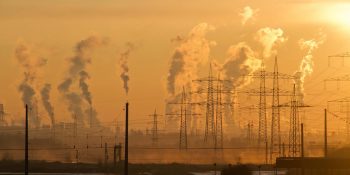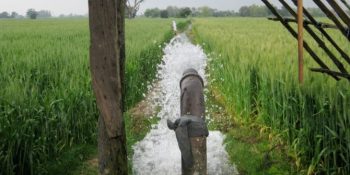Every day, millions of workers head to their jobs and breathe any number of airborne chemicals, particles or vapors, all of which may or may not be affecting their health.
Measuring these pollution exposures – and making that data meaningful to workers and employers – is both difficult and expensive. Colorado State University engineers and social scientists are working to make such measurements simpler, more affordable and more comprehensive, so that workers everywhere can know what they are breathing.
A team led by Ellison Carter and John Volckens in the Walter Scott, Jr. College of Engineering has received a four-year, $2.2 million grant from the National Institute for Occupational Safety and Health, part of the Centers for Disease Control, to develop radical new technologies and methods for assessing worker exposure to occupational air pollutants. Carter and Volckens are joined by an experienced team of engineers and social scientists who will help refine the successful adoption and deployment of the technology.
The team is developing a lightweight, inexpensive, wearable air pollution monitor for aerosol and vapor hazards that, like a commercial smartphone, is ready to use out of the box and requires minimal user training.
Testing with workers
Once they’ve created the devices, which should be no more obtrusive than name tags, the researchers plan to test them on several hundred workers in various industries – from emergency responders to product manufacturers and oil and gas drillers. The workers, who will participate voluntarily in the study, will help the scientists piece together one of most complete pictures of occupational air quality to date.
Though workers have a right to know by federal mandate what potential toxins they are exposed to, measuring the amounts of those toxins in any comprehensive way has been difficult or impossible for employers. Typically, an industrial hygienist can make about 10 measurements of personal airborne exposures each day. Collecting the data involves decades-old pump technology – similar to the aeration system in a home aquarium – and cumbersome tubing that drapes across the body. Such personal sampling trains are expensive and poorly integrated, making it virtually impossible to collect all-day data on more than 10 individual workers at a time.
The CSU researchers are pivoting off an existing technology commercialized through Volckens’ spinout company, Access Sensor Technologies. Volckens, an air pollution specialist and professor in the Department of Mechanical Engineering, led the development of a personal air sampler called the Ultrasonic Personal Air Sampler, or UPAS, that collects data on particle exposures using a silent, low-power micropump.
The new device will be a smaller, lighter version of the UPAS, explained Carter, an assistant professor in the Department of Civil and Environmental Engineering who has studied the effects of air pollution policies in China. Carter’s previous leadership in field sampling for measuring air pollution complements Volckens’ years of technology development and commercialization of personal pollution monitors.
“The technology development part is very exciting and drew me to this project,” Carter said. “The iterative design and test process is fun and has an energy to it that I’m excited to be a part of.”
Moreover, engaging with social scientists will help the technology achieve broader impact and allow the engineers to develop something that can scale to a commercial level, Carter said.
Social science component
One of the team’s social scientists is Elizabeth Williams, associate professor in the CSU Department of Communication Studies, whose expertise is at the intersection of organizational and health communication. With experience in conducting several health campaigns and health and safety initiatives, Williams researches how organizational processes influence the health of individuals.
The team also includes Ander Wilson, assistant professor in the Department of Statistics, who has expertise in managing large environmental datasets; Ashley Anderson, assistant professor in the Department of Journalism and Media Communication, who has developed quantitative methods for effective survey data collection; and Marilee Long, a professor in the same department who has expertise in effective health messaging.
The researchers hypothesize that their project will change worker- and organizational-level attitudes toward occupational hazard assessment and mitigation. The social science team will test that hypothesis by engaging with study volunteers through surveys, interviews and targeted messaging.
“We will be utilizing a citizen science approach as we focus on designing messages prior to implementation; measuring attitudinal and knowledge changes of individuals as a result of the project; and examining the influence the project has on the safety cultures within organizations,” Williams said.
As one of their study partners, the researchers will work with the Poudre Fire Authority to test their monitors on firefighters.
“First responders are one of the most vulnerable workforces to environmental hazards, they put their lives at risk, and they often pay the ultimate price,” Volckens said. “Part of our challenge is to develop something so vanishingly small and quiet and unobtrusive that those first responders will have no problem wearing these devices. A primary goal of this project is to help workers gain the information they need to make decisions that protect themselves from the unseen hazards in the air around them.”
SPREAD THE NEWS
COMMENT, Like, Follow & SHARE @I70Scout





 Fort Morgan, CO — Morgan Community College (MCC) invites the public to the Fort Morgan campus, located at 920 Barlow Road, for the groundbreaking of Poplar Hall Agriculture Center for Innovation on November 5, 2019 at 11 a.m. The Agriculture Center for Innovation at Poplar Hall will provide needed space for MCC agriculture programs, including Agriculture and Business Management (ABM), Precision Agriculture, and Unmanned Aircraft Systems. The new facility will also provide space to grow the college’s agriculture offerings, including the Industrial Controls Technician Certificate program under development. The 4,905 square foot facility will feature a classroom, computer laboratory, shop, and office space.
Fort Morgan, CO — Morgan Community College (MCC) invites the public to the Fort Morgan campus, located at 920 Barlow Road, for the groundbreaking of Poplar Hall Agriculture Center for Innovation on November 5, 2019 at 11 a.m. The Agriculture Center for Innovation at Poplar Hall will provide needed space for MCC agriculture programs, including Agriculture and Business Management (ABM), Precision Agriculture, and Unmanned Aircraft Systems. The new facility will also provide space to grow the college’s agriculture offerings, including the Industrial Controls Technician Certificate program under development. The 4,905 square foot facility will feature a classroom, computer laboratory, shop, and office space.

